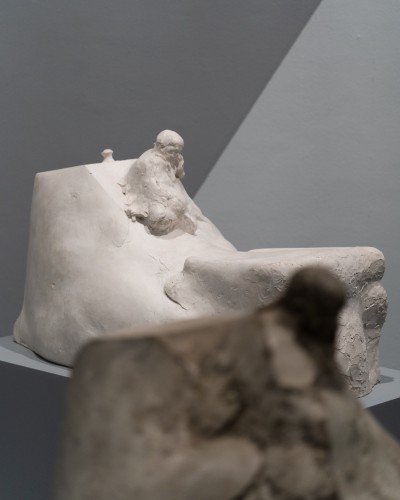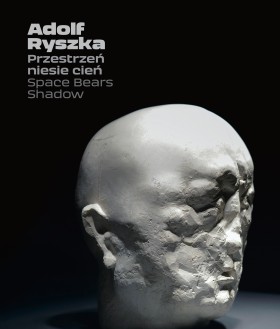Adolf Ryszka. Space Bears Shadow
25.08 – 29.10.2023 Adolf Ryszka. Space Bears Shadow
Zachęta – National Gallery of Art
curators: Dorota Grubba-Thiede, Jarosław Pajek
producer: Michał Kubiak, Karolina Jezierska-Pomorska
exhibition design: Katarzyna Anna Jarnuszkiewicz, Krystian Jarnuszkiewicz, Dorota Grubba-Thiede
sound at the exhibition: Katarzyna Podpora & Max Kohyt
works from collections: Anna Ryszka-Zalewska, Centre of Polish Sculpture in Orońsko, Królikarnia — Xawery Dunikowski Museum of Sculpture, Division of the National Museum in Warsaw, National Museum in Wrocław, Leon Wyczółkowski Regional Museum in Bydgoszcz, District Museum in Toruń, Centre of Contemporary Art Znaki Czasu in Toruń, Copper Museum in Legnica, Muzeum Sztuki in Łódź
This exhibition seeks to become something of an essay that distinguishes metaphors for our current times present in the art of Adolf Ryszka (1935–1995), a forerunner of new figuration, a tendency developing in parallel to the new wave in film and literature. The spotlight is on Ryszka’s famous works as well as those hitherto unknown, and the show features a group of small-scale sculptures that resonate with notions of organicity and concepts such as the uncanny, permutations, variability, imaginism. The sculptor built his own unique iconosphere by interpreting atrophy processes, combining the expression of the tragic and the vital, through opaque dialogues with visions of prostrate victims of wars in Pieter Bruegel the Elder.
The exhibition title is open-ended. Each visitor becomes a subject and an ‘emitter’ of shadow, co-creating the action. The configuration of plinths and the wall polychrome painting — ‘antigravitational’ as it liberates sculptures from their weight — paraphrase spatial relations in the city and engage in an ambiguous, poetic dialogue with the aura of extremely austere photographs by Fan Ho, which Katarzyna Anna Jarnuszkiewicz described as follows: ‘A human figure is traversing an empty square. This tiny, black, dynamic point between vast planes of light and shadow is unaware of participating in such a fascinating visual game.’ Shadow becomes a metaphor for community and individual life in a network of social relations. The title’s poetics and the exhibition design are meant to carry an affirmative load. To achieve this, space is approached as something whose osmotic quality is able to disperse shadow and lift the melancholia that befalls more and more regions in the world.
Ryszka created formally exquisite series, such as The Innocent, The Walking, portraits of Pablo Casals, Helmets, Sarcophagi, which became firmly established in reflection on art. The artist managed to combine sensitivity to social changes with developing innovative solutions in contemporary sculpture. He introduced organic abstraction in open space, evoking unconscious archetypes, primal imagery, horizontal compositions, characterised by their subtlety, engaging in a dialogue with earth and the ever-changing spectacle of the sky. Oskar Hansen emphasised in Open Form Theory the sublime visual-semantic powers of a turn in this very direction in terms of championing the value of life on earth, or even a philosophy of preventing wars and conflicts. In 1971, as part of the Die Strasse der Skulpturen project in St. Wendel, Germany, Ryszka carved the formally bold piece Border Stone. His most original sculptural projects also include the abstract monument Eternal Love (1973–1979, representing Władysław Żebrowski, a Franciscan, friar Zeno), which stretches gently across nearly twenty square metres in Japan, created in collaboration with Hajime Togashi.
Ryszka experimented already during his training at the Antoni Kenar High School of Fine Arts in Zakopane and at the beginning of his studies at Jerzy Jarnuszkiewicz’s sculpture studio at the Academy of Fine Arts in Warsaw. The Zachęta exhibition features mysterious gouaches that emanate colour sensitivity and evoke a touch of femininity along with an aura of Ibero-American magical realism. They seem to enter in a discreet dialogue with Paul Klee and with the work of Leonora Carrington, such as her novel The Milk of Dreams. Ryszka’s selected gouaches, enlarged, are projected on the wall, inviting a reference to painted interiors of Etruscan tombs, which held a fascination for the artist. Miron Białoszewski’s dramatised memoir Zawał [Collapse]. The sculptor shrouded some of his figurations in a peculiar aura, somewhat akin to a fairy tale. These seem to be set in the context of Susan Sontag’s broadly discussed books Illness as Metaphor (1978) and Notes on Camp (1964). ‘Corporeality’ invites an analogy to biomorphism, which, as Colin Fournier wrote in 2008, ‘appears to have the most promising future . . . among all the tendencies’.
Recognised in the international circulation, forms created by Ryszka seem to stage a conversation with an unmarked space (e.g. Missing Fragment of Space-Time from 1991), as highlighted by another eminent sculptor, the artist’s friend, Wanda Czełkowska. Their conversations about art crucially inspired the title of this show. Czełkowska stated: ‘For me, space is a person’.
The exhibition showcases the multi-sensual effect of Ryszka’s sculptures (echoing cultural revolt), while also foregrounding the context of society’s functioning. The artist enjoyed his initial success during an era of global pacifistic manifestations that sought to oppose Cold War politics and military interventions ending in a bloodshed. This pacifistic aspect compelled the Zachęta to restore the memory of Ryszka’s unique oeuvre and to acquire two of his famous works that voice opposition to violence. Owing to our collaboration with the artist’s closest family and the Centre of Polish Sculpture in Orońsko, Zachęta’s collection now includes two new masterpieces of contemporary sculpture: Innocent I (1965) and Innocent III (1968).
References to antiquity, mannerism, surrealism, and existentialism are all present in Ryszka’s work, which anticipated postmodernist strategies, sometimes tacitly understanding ‘the body’ as a marionette. Edward Gordon Craig stated: ‘The marionette is a descendant of the stone images of the old Temples — he is today a rather degenerate form of a God.’ Connotations gently introduced by Ryszka lent the figures an unreal context which sets the non-literal horizon of this exhibition.
Dorota Grubba-Thiede

-
19.10.2023 (Thu) 17:00Adolf Ryszka. Space Bears ShadowPromotion of the catalog combined with a meeting with the authors of the texts and photographs and the curators of the exhibition Dorota Grubba-Thiede and Jaroslaw PajekZachęta | Cinema Room - entrance from the ticket officeZachęta | Cinema Room - entrance from the ticket office
Adolf Ryszka. Space Bears Shadow
25.08 – 29.10.2023
Zachęta – National Gallery of Art
pl. Małachowskiego 3, 00-916 Warsaw
See on the map
Godziny otwarcia:
Tuesday – Sunday 12–8 p.m.
Thursday – free entry
ticket office is open until 7.30 p.m.



